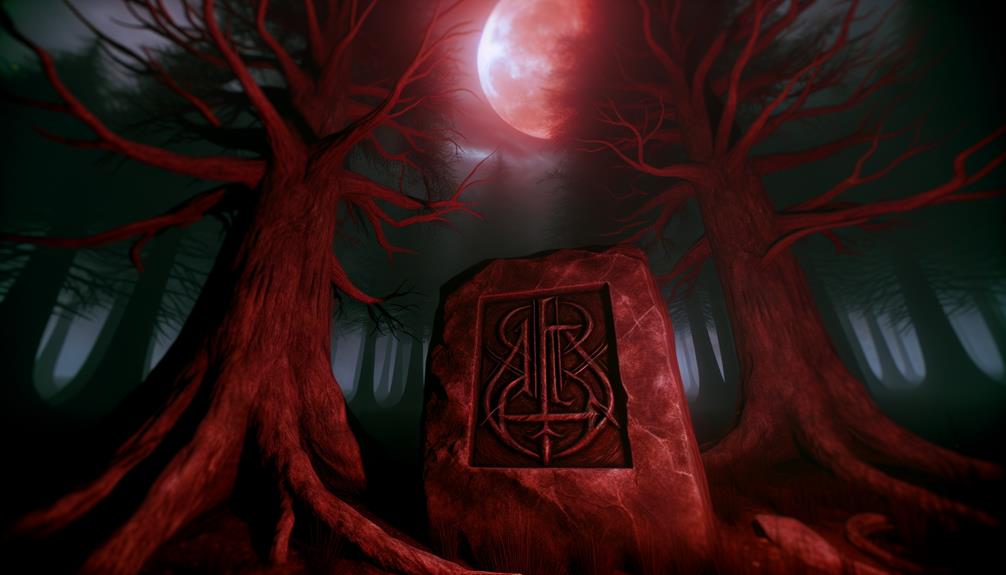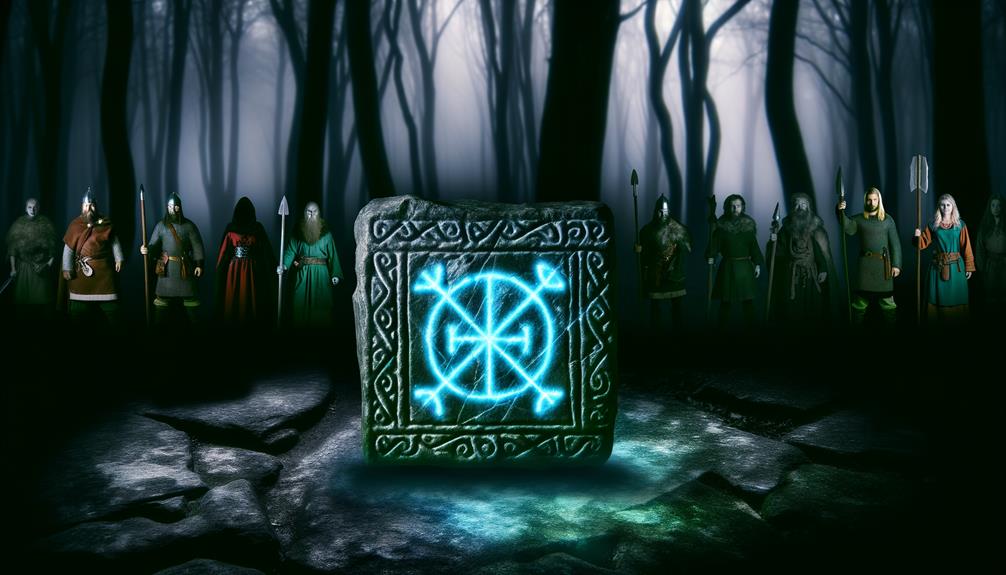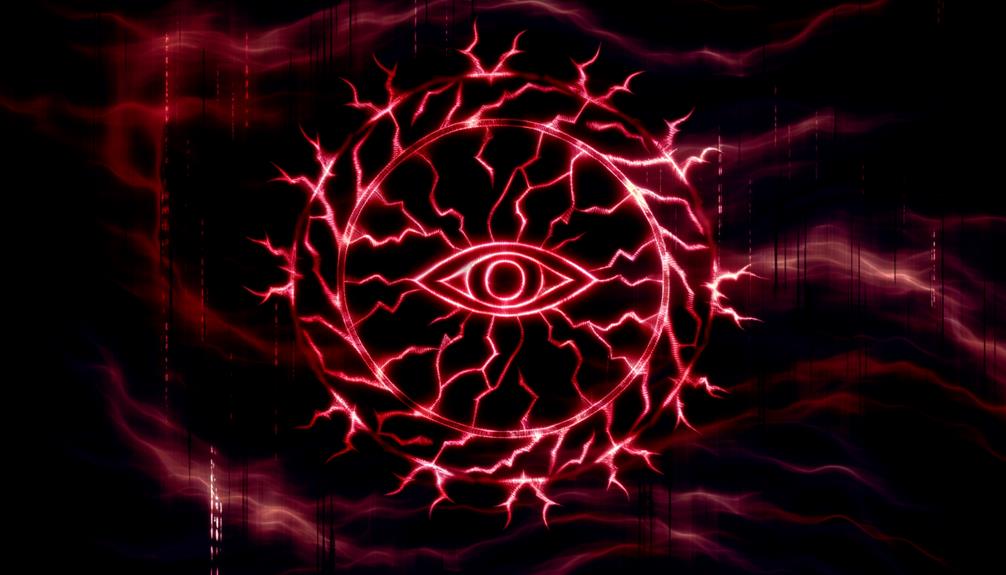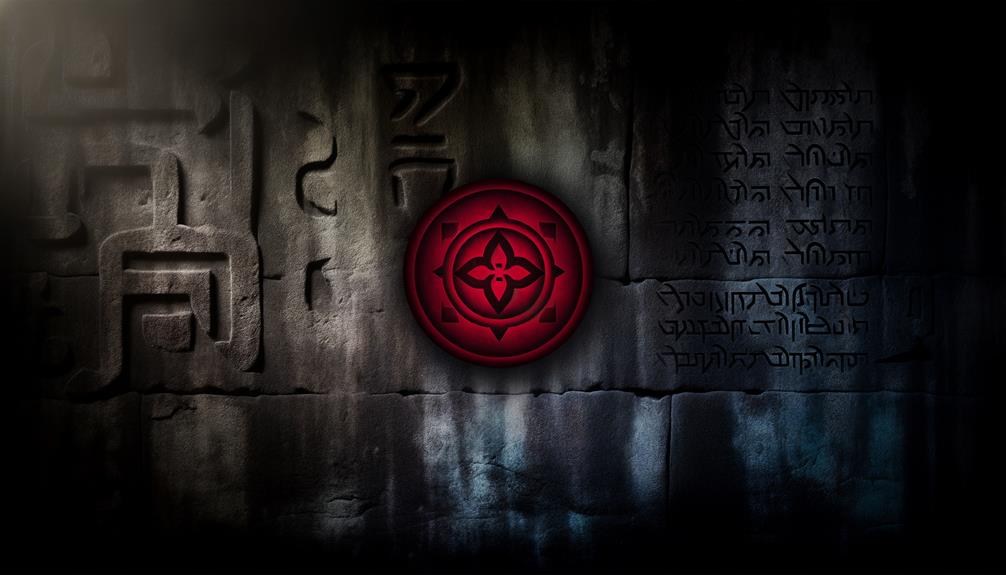What Does the Berserk Symbol Mean?
The Berserk symbol, known as the Brand of Sacrifice, represents a profound convergence of fate, suffering, and existential struggle. Inspired by medieval grimoires and Norse mythology, it embodies themes of predestination and supernatural intervention.
The symbol marks a bond between mortal and demonic domains, signifying perpetual torment and an eternal hunt by malevolent forces. It influences characters deeply, defining their motivations, actions, and psychological turmoil.
Characters like Guts and Griffith are eternally linked to it, manifesting their struggles against destiny. The Brand is a potent reminder of the inexorable forces shaping their paths.
More insights await those intrigued by its depth.

Key Takeaways
- The Brand of Sacrifice symbolizes fate, suffering, and predestination in the manga Berserk.
- It represents the eternal torment and supernatural forces that hunt characters like Guts and Casca.
- The symbol reflects themes of existential struggle, destiny, and human suffering.
- It signifies the bond between mortal and supernatural realms, emphasizing transformative pain and psychological scars.
- The Brand is a visual representation of the conflict between free will and predestined paths.
Origins of the Berserk Symbol

The origins of the Berserk symbol, a potent emblem in Kentaro Miura's acclaimed manga series 'Berserk,' can be traced back to a rich tapestry of mythological and historical influences that underpin its intricate narrative.
This symbol, often referred to as the Brand of Sacrifice, finds its roots in ancient iconography representing existential struggle and the human condition. Its design evokes the sigils used in medieval grimoires, reflecting themes of predestination and supernatural intervention.
Additionally, the symbol parallels Norse mythology's runes, which were believed to carry magical properties and fateful significance. By embedding such profound historical references, Miura not only enriches his story's depth but also invites readers to explore the complex interplay between destiny and free will in human history.
Symbolism in the Series
Central to the narrative of Berserk, the Brand of Sacrifice epitomizes the struggle between predestination and free will, symbolizing the protagonist's perpetual torment and the malevolent forces that shape his fate.
This mark, perceived as a harbinger of doom, underscores the thematic interplay of curse and destiny, reflecting the broader existential conflicts within the series.
Brand of Sacrifice
Interwoven deeply into the narrative of 'Berserk,' the Brand of Sacrifice serves as a potent symbol of fate, torment, and the inexorable bond between the mortal and supernatural domains.
Marking those chosen for the God Hand's ritual, this brand signifies perpetual suffering and an eternal hunt by demonic entities. It epitomizes the series' overarching themes of sacrifice and predestination, binding the branded to a life of ceaseless struggle.
The brand's visual design—a gruesome amalgamation of a cross and an arrow—reflects the dual nature of salvation and doom. Its presence on characters like Guts and Casca underscores the indelible impact of their past choices and the inescapable grip of destiny that shapes their harrowing journey.
Mark of Evil
Within the grim tapestry of 'Berserk,' the Mark of Evil emerges as a harrowing emblem of malevolence, encapsulating the pervasive corruption and moral decay that permeates the series.
This insidious symbol, often depicted as a grotesque and twisted form, signifies not only the presence of demonic entities but also the erosion of human virtue. It is intricately linked to the series' dark themes, serving as a visual representation of the omnipresent dread and the existential struggle faced by its characters.
In the narrative, the Mark of Evil transcends mere aesthetics, becoming a profound commentary on the inherent darkness within humanity and the relentless pull of evil forces, reflecting the series' exploration of moral ambiguity and despair.
Curse and Fate
In 'Berserk,' the intertwining motifs of curse and fate underscore the series' exploration of predestined suffering and the inexorable forces that shape the characters' lives, highlighting the profound impact of these elements on their existential journeys.
The Brand of Sacrifice, a chilling symbol central to the narrative, epitomizes this concept. It marks its bearer for a life of torment, pursued relentlessly by malevolent entities. This inescapable destiny reflects a broader commentary on human struggle against cosmic forces.
Guts, the protagonist, embodies defiance against such predetermined agony, his relentless fight symbolizing resistance to a cursed fate. Through these symbols, 'Berserk' delves deeply into themes of existential despair, challenging the notion of free will within an unforgiving universe.
Connection to Sacrifice

The theme of sacrifice in 'Berserk' is poignantly symbolized through the recurring motif of blood offerings, which serve as a harrowing indicator to the characters' struggles. This symbolic act not only underscores the narrative's exploration of power obtained through suffering but also contextualizes the profound personal and existential costs associated with such power.
Symbolic Blood Offerings
Although often viewed through the lens of its visceral brutality, the depiction of symbolic blood offerings in Berserk serves as a profound commentary on the themes of sacrifice and the human condition.
The narrative employs these offerings to underscore the weight and consequences of personal and collective sacrifices, thereby enriching its thematic complexity.
Consider the following elements:
- Ritualization of Sacrifice: Blood offerings are depicted as ritualistic acts that bind characters to their fates, elevating their personal sacrifices to a cosmic scale.
- Moral Ambiguity: These offerings often blur the lines between heroism and villainy, challenging traditional moral paradigms.
- Psychological Impact: The act of offering blood symbolizes the deep psychological scars and the irreversible changes it imprints on individuals.
This nuanced portrayal invites readers to reflect on the multifaceted nature of sacrifice.
Power Through Suffering
By examining the intricate relationship between sacrifice and the acquisition of power, Berserk elucidates how profound suffering often becomes the crucible through which characters attain transformative strength.
The narrative portrays how the protagonist, Guts, endures relentless torment and loss, symbolized by the Brand of Sacrifice, which marks him as a perpetual target for malevolent forces. This emblem of suffering paradoxically becomes a source of resilience, driving Guts to transcend his human limitations.
Similarly, Griffith's ascension to demigod status through the Eclipse ritual underscores the thematic connection between immense personal sacrifice and the attainment of unparalleled power.
Influence on Characters
Influencing the motivations and actions of several key characters, the Berserk symbol serves as a profound narrative device that shapes their journeys and psychological landscapes.
This symbol's pervasive impact can be observed through:
- Guts' Relentless Pursuit: The symbol fuels Guts' unyielding quest for vengeance and survival, embedding a sense of perpetual conflict against malevolent forces.
- Griffith's Ascendancy: It plays a critical role in Griffith's transformation, driving his ambition and the subsequent moral decay that follows his rise to power.
- Casca's Fragility: The symbol's influence manifests in Casca's psychological turmoil, illustrating her struggle with trauma and loss of identity.
These elements, embedded within the narrative, underscore the symbol's integral role in enriching character development and thematic depth.
The Brand of Sacrifice

The Brand of Sacrifice, a harrowing and indelible mark, epitomizes the central theme of suffering and predestination within the Berserk narrative. Imprinted upon characters who have been offered as sacrifices during the Eclipse, this symbol irrevocably links its bearers to a destiny fraught with torment.
Guts and Casca, the series' primary protagonists, each bear the Brand, which subjects them to relentless attacks by malevolent spirits and apostles. The Brand is not merely a physical scar; it signifies an unending connection to the astral world, rendering its victims perpetually vulnerable.
This emblematic mark hence operates as a narrative device, deepening the existential and psychological dimensions of Berserk, and accentuating the inexorable nature of their suffering and struggle against dark forces.
Themes of Fate
Fate in Berserk is intricately depicted as an omnipotent force that shapes the destinies of its characters, often drawing upon themes of inevitability and cosmic determinism. This overarching concept permeates the narrative, highlighting the struggle of individuals against preordained pathways.
Key elements include:
- The Idea of Evil: A god-like entity that embodies fate, influencing events to maintain suffering and despair, reinforcing the notion of an inescapable destiny.
- The Brand of Sacrifice: A symbol marking characters as offerings to demonic forces, signifying their entrapment within a preordained cycle of torment and death.
- Griffith's Ascension: His transformation into Femto illustrates the surrender to fate for ultimate power, revealing the costs of succumbing to destiny's allure.
These elements underscore Berserk's intricate exploration of fate.
Visual Design and Elements

Berserk's visual design and elements profoundly enhance its thematic exploration of fate, utilizing symbolic imagery and meticulous artistry to evoke the series' pervasive sense of destiny and struggle.
The Brand of Sacrifice, etched onto the protagonist Guts, epitomizes the inexorable ties to a predestined path, its jagged lines mirroring the harshness of his journey.
The series' dark, intricate artwork further intensifies these themes; the oppressive use of shadows and the grotesque detailing of monstrous foes visually manifest the omnipresent threats.
Additionally, the recurrent motif of the eclipse, a pivotal narrative and visual element, symbolizes catastrophic life-altering events, casting a foreboding pall over the characters' fates.
This way, Kentaro Miura's artistry intricately intertwines with the narrative, creating a compelling visual symphony of fate.
Fan Interpretations
Among the myriad of fan interpretations, many emphasize the profound existential and philosophical implications embedded within the series' symbolic elements. These interpretations often explore how the Berserk symbol encapsulates the narrative's examination of fate, human suffering, and the struggle for autonomy.
Fate and Determinism: Fans argue that the symbol represents a predestined path, reflecting the protagonist's unavoidable trials.
Human Suffering: The symbol is frequently seen as a reminder of the widespread agony and torment that characters endure, echoing themes of resilience.
Autonomy and Rebellion: Another common interpretation is that the symbol signifies the relentless fight against a seemingly indifferent universe, embodying the pursuit of self-determination against overwhelming odds.
These perspectives enrich the narrative, offering layered insights into its thematic core.
Cultural Impact

The rich tapestry of interpretations surrounding the Berserk symbol underscores its profound cultural impact, influencing not only fans but also a broader audience fascinated by its philosophical and existential resonances.
The symbol, emblematic of struggle and fate, resonates within various subcultures, from graphic novels to video games, embedding itself in the collective consciousness.
Its presence in mainstream media highlights society's preoccupation with themes of destiny, sacrifice, and the human condition.
Critics and scholars often draw parallels between the Berserk symbol and classic literary motifs, invoking comparisons to existentialist thought and mythological archetypes.
This cross-cultural relevance accentuates the symbol's ability to transcend its original context, fostering a deeper, universal dialogue about life's inherent chaos and the pursuit of meaning.
Conclusion
The Berserk symbol, deeply embedded in the narrative tapestry of the series, serves as a harbinger of destiny, echoing themes of sacrifice and inexorable fate reminiscent of tragic mythologies. Its intricate design and significant placement underscore its influence on character arcs and thematic development.
Through visual and symbolic resonance, the symbol perpetuates a dialogue on predestination and suffering, inviting interpretations that transcend the narrative, thereby cementing its cultural and thematic prominence within the oeuvre of dark fantasy literature.




